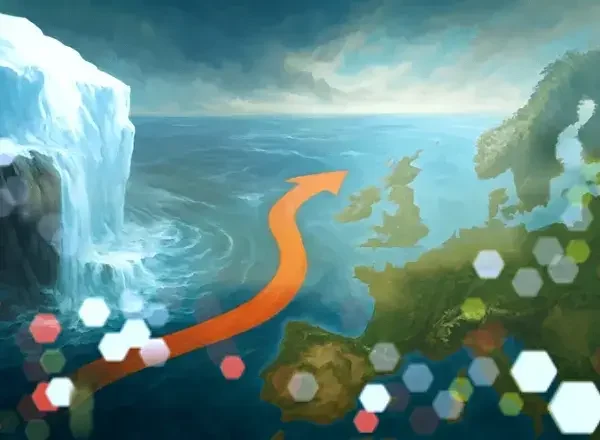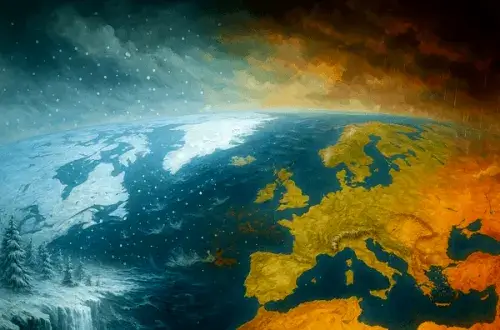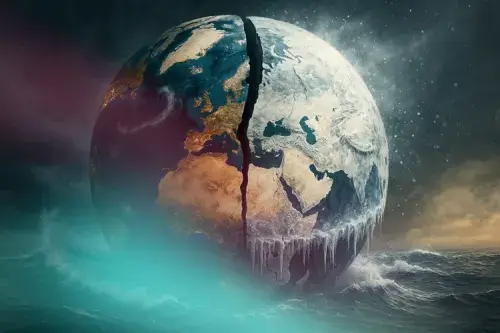The Gulf Stream, more accurately known as the Atlantic Meridional Overturning Circulation (AMOC), is a colossal ocean current system. This “ocean conveyor belt” acts as a global thermostat, moving warm, tropical water from the equator towards the North Atlantic.
This process is the primary reason why Northern Europe has a much milder climate than other regions at the same latitude, such as Canada. Without it, the familiar way of life on the continent would be unrecognizable.
It’s a phenomenon that has fascinated and concerned scientists for decades, and its potential future has become a matter of widespread public interest.
What if this essential current system, which has regulated our climate for millennia, were to slow down or even stop?
While a complete and sudden collapse isn’t expected in the immediate future, a significant slowdown is already underway, and the consequences could be globally transformative.
Gulf Stream, the Threat.
A Slowing Current and a Changing Climate.
The primary threat to the AMOC is global warming. As the Earth’s temperature rises, large ice sheets, particularly the massive Greenland ice sheet, melt at an accelerated rate. This introduces a vast quantity of fresh water into the North Atlantic.
The intricate mechanics of the AMOC depend on a delicate balance of temperature and salinity. Warm, salty water from the tropics is carried north, where it cools and becomes denser.
This dense, cold water then sinks to the bottom of the ocean, pulling more warm water behind it in a continuous cycle. It’s this “sinking” process that acts as the engine of the entire system. However, when fresh water from melting glaciers dilutes the salty ocean water, it becomes less dense.
This lighter water doesn’t sink as efficiently, weakening the “pump” that drives the entire circulation. Satellite data and oceanographic measurements have already confirmed this process is happening.
The AMOC is measurably slowing down, raising a critical question: what will happen if it continues to weaken?
The Global Ripple Effect.
The consequences of a significant AMOC slowdown would be far-reaching, fundamentally altering climate patterns across the globe.
Europe’s Big Chill.
The most immediate and dramatic effect would be a sharp drop in temperatures across Europe. Winters could become bitterly cold, with average temperatures plunging by 3 to 7°C (5 to 12.5°F), and some regions experiencing even more severe drops of up to 10°C (18°F).
The mild, temperate climate that has long defined the continent’s agriculture and lifestyle would be replaced by frigid conditions.
Tropical Disruption.
The effects wouldn’t be limited to the North Atlantic. The AMOC’s slowdown would alter the Intertropical Convergence Zone (ITCZ), a crucial band of low pressure that circles the Earth near the equator and governs tropical rainfall.
The ITCZ would shift south, disrupting monsoons in the Sahel region of Africa and parts of South Asia. This shift could lead to more frequent and prolonged droughts in the northern tropics while intensifying destructive rainfall events in some parts of the southern tropics.
The Impact on Human Society.
This isn’t a doomsday scenario from a science fiction movie; it’s a real-world threat that would profoundly impact human society.
• Economic Strain: A colder Europe would require massive increases in energy for heating, placing an enormous strain on energy grids and economies.
• Agricultural Collapse: European agriculture, accustomed to a moderate climate, would face widespread crop failures due to frost and shorter growing seasons. Simultaneously, droughts in Africa and Asia would jeopardize food security for millions, potentially leading to famine.
• Migration and Instability: The combination of food shortages, economic collapse, and extreme weather would likely trigger mass migrations. People would be forced to seek more hospitable regions, creating unprecedented humanitarian crises and political instability on a global scale.
Where Could You Go?
Seeking a Safer Climate.
While the prospect of an AMOC collapse is grim, some regions would be better equipped to handle the resulting climate shifts. These areas offer a degree of climatic stability, either because they are outside the AMOC’s direct influence or because their location provides a natural buffer.
Southern Europe.
Countries like Spain, Portugal, Italy, and Greece would still experience cooler temperatures but would be less affected than their northern counterparts. Their proximity to the equator provides a “thermal buffer,” making them more resilient to the cold. While agriculture would suffer, it wouldn’t face the complete collapse that might occur in the north.
Southern America.
The southern parts of Brazil, Argentina, and Chile are in a separate climate system. While they face their own climate challenges, the AMOC’s direct influence on their weather is minimal. These regions might even benefit from more moderate temperatures and more predictable rainfall.
Australia and New Zealand.
These island nations are governed by their own unique climate systems and are largely unaffected by the AMOC. While they face their own set of threats, such as droughts and wildfires, they would remain relatively stable compared to the dramatic changes in the Northern Hemisphere.
Southeast Asia.
Regions like Indonesia, the Philippines, and Vietnam would retain their warm temperatures and high biodiversity. While they would face challenges from rising sea levels and more intense typhoons, their agricultural and ecological systems would remain functional.
A Call for Action.
A full collapse of the AMOC isn’t imminent, but its measured slowdown is a clear warning sign. Scientists agree that the risk of a tipping point will only increase if greenhouse gas emissions continue to rise unchecked.
The earlier the world can reduce its carbon footprint and mitigate climate change, the lower the probability of facing this devastating scenario.
The potential for the Gulf Stream to slow or stop is not a work of fiction; it’s a real and growing threat. Its effects would be felt globally, reshaping societies, economies, and migration patterns.
The most resilient places would be those with a natural combination of warmth and moisture, primarily in the Southern Hemisphere and the southern latitudes of Europe and Asia.
The Northern Hemisphere above the 50th parallel, including Northern Europe and parts of Canada, would bear the brunt of the changes.
The fate of this vital ocean current, and with it, the stability of our global climate, rests on the actions we take today.
What steps do you think are most important for mitigating this risk?
Have a Great Day!




